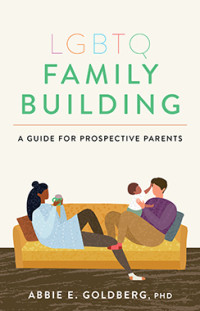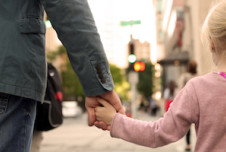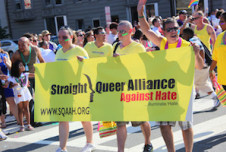We live in a heteronormative society.

The heteronormative family is traditionally gendered, white, and middle- to upper-middle-class, and is characterized by biological parent-child relationships. In turn, people in general are assumed to be heterosexual, expected to marry people of the “other” gender, and expected to procreate with their monogamous, different-gender partners.
LGBTQ (lesbian, gay, bisexual, transgender [trans], queer) people by their very nature exist outside of the sexual (and perhaps gender) binary and, often, the family binary in that any families they create will be considered “deviant”—that is, if their children are not conceived by a “real” man and a “real” woman in a heterosexual procreative context.
Children with LGBTQ parents are likely exposed to media, including TV and children’s books, that disproportionately represent mother-father families. In turn, as they develop, they become increasingly aware of how their families differ from those most commonly depicted in the media as well as those that surround them in their schools and communities. Also, children gradually develop a sense of whether and how their family deviates from the dominant norm in other ways, such as with regard to racial makeup and gender expression.
Part of my goal as a researcher and psychologist is to understand and amplify the experiences of LGBTQ parents and their children, and learn lessons about how to help them along their parenting journeys.
My new book LGBTQ Family Building: A Guide for Prospective Parents addresses how to help children navigate heterosexist bias in the world, alongside many other practical tips for LGBTQ readers who are considering becoming parents (or are parents already), such as choosing LGBTQ-friendly health care providers and day cares, or navigating those that are less than LGBTQ-friendly. By preparing children for the biases and misunderstandings they might face, we can help them feel proud, empowered, and loved in the family they have.
Talking to kids about family
As an LGBTQ parent who wants to help your kid navigate prejudice in the world, you should focus on a couple of primary messages starting at preschool age: family diversity (i.e., families come in all different shapes and sizes), love (i.e., your child is loved; love is an important part of what makes a family), and values (i.e., all families are valid; no one type of family is better than others).
Beyond that, there are several important principles you can follow when talking to your kids about their family:
Establish the basic story of your family and build in the details as your child gets older and can grasp their meaning. A preschooler will not understand the legal intricacies of adoption, nor will they understand the specifics of reproductive technologies. However, you can still share the basic narrative that another person was involved in helping your family come to be.
As your child develops, you can share more details. Diane Ehrensaft’s book Mommies, Daddies, Donors, Surrogates: Answering Tough Questions and Building Strong Families is a great resource to help you prepare for and think about these conversations. For children, Cory Silverberg’s What Makes a Baby and Keiko Kasza’s A Mother for Choco are useful starting points for talking about donor insemination and adoption, respectively.
Tell the truth—always—but keep it simple. If your child is adopted, you can and should talk about their birth parents. However, you do not need to explain in detail the circumstances that led to your child’s adoption until they are able to comprehend and absorb such information.
At the preschool stage and earlier, you might share that your child’s birth mother did not have a place to live at the time that they were born, but you do not need to provide details about her drug addiction, for example. A young child can probably understand the importance of having a home to raise a baby, but they cannot understand substance use or addiction.
Look for natural openings to talk about and normalize the idea of “all types of families” as well as your particular family-building story. Books, TV shows, and movies are great jumping-off places for such conversations. You can use these to highlight your own family (“Oh, look! [Character] has two moms, too!”) as well as other types of families (for example, single-parent, grandparent-headed, adoptive) to underscore family diversity. A great book for starting this type of conversation is Todd Parr’s The Family Book.
 This essay is adapted from LGBTQ Family Building: A Guide for Prospective Parents (APA LifeTools, 2022 295 pages).
This essay is adapted from LGBTQ Family Building: A Guide for Prospective Parents (APA LifeTools, 2022 295 pages).
Listen to the question that is asked and keep your response simple and straightforward. For example, a question like, “Why don’t I have a dad?” warrants a response—but one that is fairly basic. You can “level up” the complexity as your child develops and matures. Try not to let your anxiety get the best of you, and remember that there is no need to explain the details of human reproduction to a three year old.
Allow children to enact fantasies and roles. If your child has two dads and they insist on a mom doll for their dollhouse, or your child plays “house” with a mother and a father, do not try to correct their play or explain that they have “two dads, no mom.” Allowing your child the freedom of exploring different family types, roles, and identities is good for their development. Perhaps your child’s play is a way of processing experiences and feelings, or maybe it is simply creative experimentation. Or perhaps your child is imitating what they see in their friends’ families or in the dominant media. You can always ask questions (“Tell me about the mom in this family. What’s she like?”), but try to do so without an “agenda.”
Dealing with peer prejudice
As children develop, they will not only notice how their family differs from a lot of the families around them but may also come into contact with people, including teachers and classmates, who challenge their ideas about their family’s value and legitimacy.
As part of writing my book, I surveyed over 500 LGBTQ parents about how they built their families and their experiences of parenting. Many parents highlighted situations in which their young children encountered peers who questioned or doubted their family’s formation or origin story (for example, their peers asked what a donor was or wondered how a child could simply not have a dad), as well as peers who used the word “gay” in a negative way.
In some cases, children were teased by their peers, whereas in others, they were simply excluded (for example, they were not invited to a birthday party if a peer’s parents knew that they had LGBTQ parents). Some young children were described as coming into contact with teachers, camp counselors, and other adults who invalidated their families in some way—for example, failing to acknowledge their particular type of family in curricula, holiday celebrations, and storytelling and, occasionally, challenging them or silencing them when they shared details of their families.
At the preschool or early elementary school age, peers might reveal their ignorance or lack of understanding about LGBTQ-parent families through asking questions or making statements like the following:
- “Why don’t you have a [dad/mom]?”
- “You don’t have two dads. I don’t believe you.”
- “That’s so gay.”
- “I thought that other lady was your mom . . . ?”
- “You have two dads? That’s so [weird/gross].”
- “Your parents are gay, right? Are you gay, too?”
- “You’re adopted? Wow. Where did they get you from?”
- “Why didn’t your parents [want you/raise you/keep you]?”
- “Is that your mom or your dad? I can’t tell. They don’t look like a woman or a man.”
- “Why does your mom have such a deep voice?”
Hopefully, your child will have a strong foundation of empowerment and support within their family so that by the time they encounter this type of interaction, they will have absorbed the truth that their family is valid and that they are loved.
To that end, it can be helpful to remind children of their innate worth and individuality. There will always be something—and hopefully more than one thing—that will make them stand apart. It is both our differences and our similarities that make the world an interesting and complex place.
If your child is being bullied or harassed, it is essential that you remind them that this is not acceptable and that they are not responsible for correcting or accepting other people’s ignorance. It is not their job to defend or educate. Ideally, there will be other people in their world, such as teachers and support staff, who will play the important role of correcting ignorance and misconceptions about LGBTQ identities and parenthood.
Your child deserves connections and resources that reflect and validate their family. For example, organizations like COLAGE and Family Equality offer in-person and virtual opportunities to connect with other children with LGBTQ parents. There are also numerous online spaces, not to mention documentaries and an increasing number of TV shows and other media, that reflect and embrace LGBTQ-parent families.
To be clear: Teasing, bullying, and general misunderstanding are a direct result of heteronormativity. We all parent within a society that continues to hold fast to certain ideas and ideals related to families, gender, and parenthood. Consider yourself part of the not-so-quiet revolution of destabilizing these ideas and ideals, which only serve to keep families and people in boxes and limit our agency and autonomy as human beings.







Comments